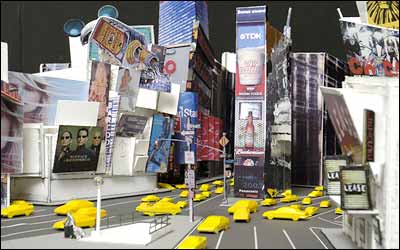
“I was in Las Vegas, in a meeting with Cirque du Soleil, and I got a phone call from [Hollywood producer] Scott Rudin,” says David Rockwell, perhaps the only New York architect who will ever say such a thing. Seated at a conference table in his Union Square office, surrounded by dozens of sketches and two publicists, Rockwell is recalling the day Rudin recruited him for his latest project: the Janeane Garofalo–beheading, Michael Moore–lambasting, nearly NC-17 Team America. Scripted and voice-acted by South Park’s TreyParker and Matt Stone, the film (which was still being edited at press time) is intended as both an adventure romp and a satirical riff on the war on terror. All Rockwell had to do was build the sets. The trick was, the acting would be done by marionettes. And the marionettes would speechify, kill, torture, and have onscreen sex.
For most architects, this might not be the most natural match. But Rockwell has gained a reputation as the cheerful Barnum of the design world: unashamedly self-promoting and best known for his (depending on one’s perspective) boldly festive, or crassly populist, designs. His projects are so varied as to be barely classifiable: the Zen monochromatics of the W Hotels and Nobu; the insanely campy giant teepee in the Mohegan Sun casino, the sparkly Las Vegas roost he’s planning for Phantom of the Opera, and the magpie excess of Broadway’s Hairspray. Perhaps no New York architect has more fun—or is less afraid of overkill.
“I’ve always been a big fan of South Park,” says Rockwell. “And I couldn’t imagine a project more outside the box. Architects are interested in permanence; this is the opposite end of the extreme.”
Perhaps most appealing to Rockwell was the unfinished nature of the movie’s puppet sets, so similar to early-stage architectural models. As with South Park’s deliberately crude animation, the Team America design was meant to highlight the stiff absurdity of the puppets—and then get blown apart. “Occasionally, we sprinkle in these elements that reveal that the marionettes are only two feet tall,” he says. A scaled-down lamp inside the bedroom of one heroine is actually a tiny Philippe Starck juicer.
“Throughout, we tried to create a world that had its own bizarre logic—a reductive American view of the world.” Mimicking the oversimplified patriotism of the film’s terror-fighting task force, Rockwell designed an Egyptian skyline filled with pyramids; Hollywood palm trees of shredded dollars; a home base where jets launch from Mount Rushmore; an “Albert Speer meets Liberace” palace for the loony Kim Jong-il surrounded by shanties made of “tea-stained Chinese-food containers.”
For freedom-hating Paris, Rockwell crammed the monuments together, so a missile could fly through the Arc de Triomphe and the Eiffel Tower before obliterating the nearby Louvre. “See the sidewalks?” he says. “Those are croissants in the stones.” In Times Square (pictured, right, in an early version; photorealistic detail was added later) the buildings are extra-vertical, all the cars are yellow cabs, and a Broadway marquee advertises the musical LEASE.
Of course, some such details are more personal than others. Rockwell took the Loews cinema he designed for 42nd Street and moved it into more prime real estate. “I wanted to take away everything but the signs,” Rockwell notes happily. “Look! A sign for Hairspray.”